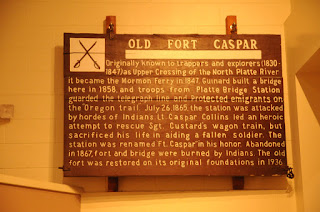We're going to end this month's tour of Fort Caspar with some history. This is the original sign that detailed the fort's history. Unfortunately, it wasn't totally accurate.
As you can see from the following explanation, several important facts were misstated.
Regardless of the earlier inaccuracies, the fort is an interesting example of nineteenth century military life in Wyoming and a dramatic contrast to Fort Laramie. I encourage you to visit both if you're ever in Wyoming.
Wednesday, November 29, 2017
Wednesday, November 22, 2017
Wednesday in Wyoming -- November 22, 2017
Can you guess what this is? After showing you how officers and enlisted men lived at Fort Caspar, I couldn't resist letting you see how the horses fared. Yes, this is the stable.
Each of the stalls has a bin for hay and a basin for water. Judging from this, it appears that the horses had more privacy than enlisted men. Hmmm... What does that tell you?
Each of the stalls has a bin for hay and a basin for water. Judging from this, it appears that the horses had more privacy than enlisted men. Hmmm... What does that tell you?
Wednesday, November 15, 2017
Wednesday in Wyoming -- November 15, 2017
Last week we saw an officer's quarters at Fort Caspar. Today you'll see how different life was in the enlisted men's barracks.
One large room served as sleeping, eating, and recreational space for many men. And, if you're thinking that the beds look reasonably sized, it's because each of them was designed to sleep two.
One large room served as sleeping, eating, and recreational space for many men. And, if you're thinking that the beds look reasonably sized, it's because each of them was designed to sleep two.
Wednesday, November 8, 2017
Wednesday in Wyoming -- November 8, 2017
Officers who were stationed at Fort Caspar had relatively comfortable lives, including private rooms with large fireplaces (a definite necessity in the cold Wyoming winters), writing desks, and warm rugs.
What surprised me was that they stored their saddles in their rooms.
What surprised me was that they stored their saddles in their rooms.
Wednesday, November 1, 2017
Wednesday in Wyoming -- November 1, 2017
The actual fort was dismantled and its buildings used in the construction of Fort Fetterman, but the site was of enough importance that the buildings were reconstructed as a WPA project during the Depression.
Although the WPA used historically accurate building techniques, one decidedly non-historic element has been added: an electric meter.
Subscribe to:
Posts (Atom)








